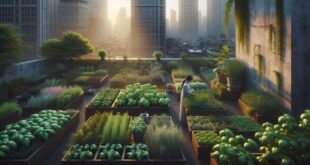Choosing the right chicken breed and building a smart, respectful coop are crucial steps in successful urban farming—where space, legality, and intention intersect with food independence and daily ritual. Not all hens thrive in cityscapes, but the right ones can redefine homegrown resilience.
Read More »Sustainable Sanctuaries
The Challenges of Composting in Small Urban Spaces
Composting in small urban spaces blends creativity, intuition, and sustainable living. From bokashi bins to rooftop co-ops, each method turns food waste into renewal — even in a 700-square-foot apartment. Discover how decay becomes design in the rhythm of modern city life.
Read More »Sustainable Rooftop Farming: Turning Your Roof into a Garden
Hidden above the chaos of city life, rooftop farming reimagines urban space—offering not just food, but cooling, community, and connection. From structural design to soil care, it’s a quiet revolution growing where concrete once ruled.
Read More »Greywater Recycling Systems for City Apartments
Greywater reuse transforms urban apartments into hubs of renewal, challenging traditional water habits. By recirculating gently used water, even compact homes can cut waste, lower costs, and reconnect with nature’s rhythms — offering a quiet revolution within the plumbing of daily life.
Read More »The Role of Community Gardens in Urban Sustainability
Community gardens are transforming cities by reconnecting people with land, food, and each other—reviving lost knowledge, fostering resilience, and quietly reshaping urban ecosystems and justice.
Read More »Hydroponics at Home: Growing Food Without Soil in Small Spaces
Hydroponics transforms limited spaces into thriving food sources by replacing soil with water-based nutrients. From silent wick setups to vertical towers, each system aligns with rhythm, resourcefulness, and resilience—redefining how nourishment takes root in urban life.
Read More »The Benefits and Drawbacks of Tiny House Living in Urban Areas
Urban tiny homes offer a path to intentional living, blending minimalist design, sustainable practices, and creative solutions within compact spaces—challenging traditional housing norms while fostering resilience, presence, and purpose amid the noise of city life.
Read More »Suburban Self-Sufficiency: Balancing City Convenience with Rural Independence
Lawns become gardens, sheds gain purpose, and chickens join the cast—suburban spaces evolve into hubs of resilience through smart tech, homegrown food, and local cooperation, proving self-reliance isn't reserved for rural homesteads.
Read More »Transitioning from Urban Life to Rural Homesteading: A Step-by-Step Guide
Choosing the right homestead location shapes everything from food production to emergency access. Soil quality, water availability, climate, and legal restrictions all play critical roles in long-term sustainability. Weighing isolation against accessibility and understanding local community dynamics can make the difference between success and struggle.
Read More »The Hidden Dangers of Cheap LEDs in Your Sustainable Home
Cheap LEDs promise energy savings, but hidden dangers lurk beneath the surface. Inferior components, poor thermal management, and flicker issues can lead to premature failure, eye strain, and even fire risks. Some low-cost options contain hazardous materials, while others emit excessive blue light that disrupts sleep. Understanding what sets high-quality LEDs apart ensures safer, longer-lasting illumination.
Read More » DS Haven In Light Of Things
DS Haven In Light Of Things









